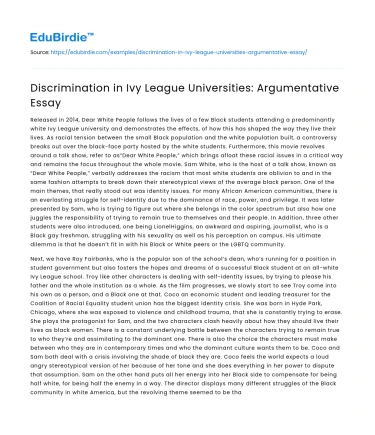Released in 2014, Dear White People follows the lives of a few Black students attending a predominantly white Ivy League university and demonstrates the effects, of how this has shaped the way they live their lives. As racial tension between the small Black population and the white population built, a controversy breaks out over the black-face party hosted by the white students. Furthermore, this movie revolves around a talk show, refer to as“Dear White People,” which brings afloat these racial issues in a critical way and remains the focus throughout the whole movie. Sam White, who is the host of a talk show, known as “Dear White People,” verbally addresses the racism that most white students are oblivion to and in the same fashion attempts to break down their stereotypical views of the average black person. One of the main themes, that really stood out was identity issues. For many African American communities, there is an everlasting struggle for self-identity due to the dominance of race, power, and privilege. It was later presented by Sam, who is trying to figure out where she belongs in the color spectrum but also how one juggles the responsibility of trying to remain true to themselves and their people. In Addition, three other students were also introduced, one being LionelHiggins, an awkward and aspiring, journalist, who is a Black gay freshman, struggling with his sexuality as well as his perception on campus. His ultimate dilemma is that he doesn’t fit in with his Black or White peers or the LGBTQ community.
Next, we have Roy Fairbanks, who is the popular son of the school’s dean, who’s running for a position in student government but also fosters the hopes and dreams of a successful Black student at an all-white Ivy League school. Troy like other characters is dealing with self-identity issues, by trying to please his father and the whole institution as a whole. As the film progresses, we slowly start to see Troy come into his own as a person, and a Black one at that. Coco an economic student and leading treasurer for the Coalition of Racial Equality student union has the biggest identity crisis. She was born in Hyde Park, Chicago, where she was exposed to violence and childhood trauma, that she is constantly trying to erase. She plays the protagonist for Sam, and the two characters clash heavily about how they should live their lives as black women. There is a constant underlying battle between the characters trying to remain true to who they’re and assimilating to the dominant one. There is also the choice the characters must make between who they are in contemporary times and who the dominant culture wants them to be. Coco and Sam both deal with a crisis involving the shade of black they are. Coco feels the world expects a loud angry stereotypical version of her because of her tone and she does everything in her power to dispute that assumption. Sam on the other hand puts all her energy into her Black side to compensate for being half white, for being half the enemy in a way. The director displays many different struggles of the Black community in white America, but the revolving theme seemed to be that every single Black person must be twice as good and forms a double consciousness that most students in the film don’t even think about. The director also focuses in on how blind and painfully ignorant it is to live in this illusion of a post-racist America. Many people today say that we are past race and that they do not see color, but as portrayed in the film racism is still very much alive. This is proved by the fact that the demonstrations used are not
Save your time!
We can take care of your essay
- Proper editing and formatting
- Free revision, title page, and bibliography
- Flexible prices and money-back guarantee
Jones3farfetched or dramatized in any way, things like black face parties have happened across many college campuses in just the past few years. These examples are not old or extreme, they are current issues that Black people must deal with and overcome every single day, in every phase of their lives. This film matters because it touches on the issues that many Black students face today. The issue the movie is trying to address, and the highlight is that there are still people who exist and find stereotyping African American people (black-face party) acceptable. It’s not meant to attack white people, or even be ‘anti-white’ in general, but tackle the problems certain minorities face daily. That’s why the setting took place in an all-white Ivy League school because mainly people who are born into rich families go there(white and privileged individuals), and by doing so, the film depicted the ignorance of some of those people who are willing to participate in these wrongful activities. This fits into the larger discussion by raising the bigger question, how are we as Black people deciding to move forward and how are we going to hold others accountable? Just like Black Lives Matter and our contemporary African American class, we must continue to educate one another and highlight our issues and concerns.






 Stuck on your essay?
Stuck on your essay?

